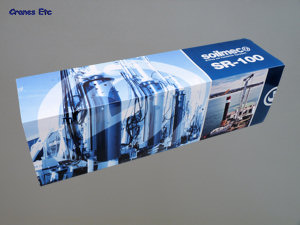 | | The Soilmec branded box. | 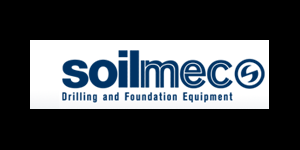 | 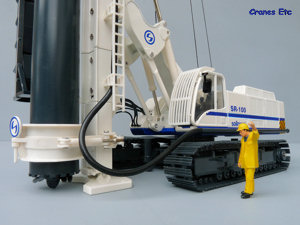 | | The concrete supply hose plugs into the line along the body. |  | | Soilmec name and logo at the rear. | 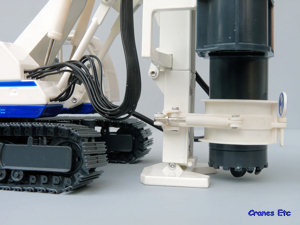 | | Hydraulic lines from the body. | 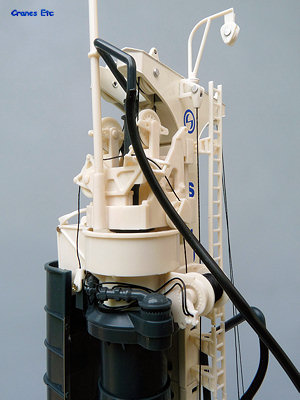 | | Complicated modelling. Much of it is plastic. |  | | Body shows the plastic parts as slightly off colour. | 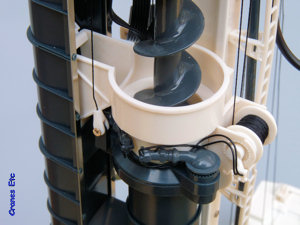 | | The spoil removal hopper where spoil brought up by the auger is discharged to the chute on the left. | 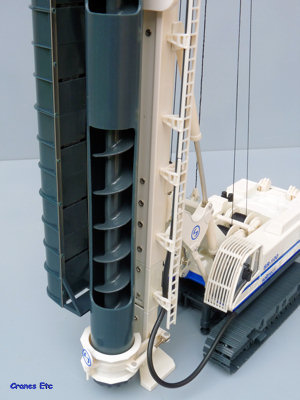 | | The casing has cut-outs so the auger is visible for display purposes. It can be rotated out of view. | 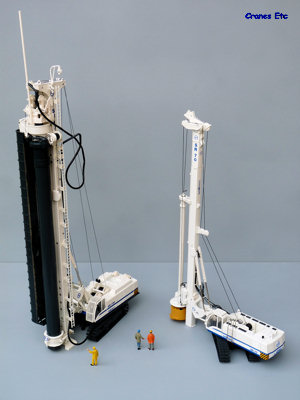 | | It pairs very well with the Soilmec SR-70. |
| The Soilmec SR-100 is the largest large diameter piling machine in the current Soilmec range and has an operating weight of 140 tonnes. As an auger it can drill to depths of 92m in diameters up to 3500mm. The model is rigged in Cased Auger Pile configuration. In this mode a continuous flight auger excavates as a casing is driven at the same time. As the auger is withdrawn concrete is pumped in and then the casing is withdrawn. A reinforcement cage is finally vibrated in. This machine can construct piles very rapidly in non-cohesive soils without the use of drilling mud. In this configuration it can handle piles up to 1200mm diameter and up to 27m deep.
Packaging
It comes in a large Soilmec branded box with some photos on the outside and a description of the applications the SR-100 was designed for. Inside the box, it is contained within a couple of expanded polystyrene trays. The review model was undamaged and had no missing parts.
There is no other information on the real machine included, and no instructions for the model. It is fully reeved and rigged in the box with only the auxiliary winch head to be fitted at the top of the mast. A key is provided to operate the various winches. The model has a number of functions and some instructions would certainly have been a worthwhile addition to the model.
Detail
The tracks are metal and are mounted on nicely formed track frames which have stepping plates although there are no working rollers, and the main drive sprocket is fixed on a silver pin which spoils the look a little. Between the tracks are four outriggers for supporting the body when the tracks are removed and these are all metal.
The body is metal with some good detailing of the various grilles and other features in the bodywork. A good metal access ladder leads to the roof. The operator's cab has a mirror and a plastic debris guard on the windscreen. Inside the controls are modelled although the knobs on the levers would scale to be the size of grapefruit. However overall it looks effective. There are a couple of winches in the body and these are accessed through holes in the bodywork, but these are not too obtrusive. The winches and some pulley sheaves at the rear are in white plastic and the colour difference to the painted metal is enough to notice. At the rear the counterweight has the Soilmec name and logo nicely produced in relief.
Plenty of hydraulic hoses run from the front of the machine to mast, and the parallelogram system is neatly modelled. The mast is metal. At the bottom is a clamp for the casing and this is a plastic part with a quaint Soilmec pin rather than something realistic. An access ladder runs the length of the mast and a concrete delivery tube connects to the body and the rotary head.
The cathead at the top of the mast is metal with plastic sheaves and a basic auxiliary winch support attaches at the top.
The rotary head is a detailed part albeit it is entirely of plastic. Hydraulic lines run to the drive motors and the rope drives are fully modelled. A plastic full length continuous flight auger is attached to the rotary head and it has a plastic casing around it. The casing has a couple of cut outs in it which allow the auger to be seen inside. Fortunately it is possible to position the cut outs away from view so realistic poses can be obtained.
To the side of the auger is the spoil removal system. It is largely plastic but looks pretty good. The hopper discharge and casing drive are also plastic but the detail is good with fine hydraulic lines to the various motors.
Features
The tracks roll well and can be taken off the sprockets easily as they are spring loaded. The track frames extend and retract so the model can be posed in drilling or transport mode. The outriggers can be rotated into position and the pads screwed down, but there appears to be no easy way to remove the whole track frames for transport.
The mast can be raised and lowered into position and the parallelogram mechanism works well. The casing clamp at the foot of the mast can be opened and closed, and the casing can be fully removed from the model.
Three of the winches work. The rotary head can be raised and lowered, and there is a winch for the spoil hopper and one for sledge on the mast. One of the lines from the body is reeved to a blind end and this is presumably the rotary head crowd line.
The spoil chute has a neat mechanism comprising a series of hinged flaps which fold as the casing is driven in, and this works pretty well.
The counterweight can be removed although it is not very heavy but it has an internal plastic box which could be loaded with weights if desired. The mast is made in such a way that it could be folded for transport with both the cathead and mast foot hinged. Things get a little more difficult with the spoil removal chute and casing clamp where a number of screws would have to be undone to disassemble the model.
The rotary head and spoil chute and casing drive can be slid off the mast although the auger seems permanently attached to the rotary head. However although it looks like the model has been designed to be stripped for transport the hydraulic lines and concrete delivery pipe work have been glued in place meaning that surgery on the model is required to show the SR-100 being transported. It is disappointing as with just a little more effort a more flexible model could have resulted.
Quality
The model is fairly good quality. The castings are quite good but there is a fair amount of plastic on the model and colour of the white plastic parts is slightly different to the metal parts so is visible under close inspection. The paintwork and graphics are satisfactory.
Price
The model is a little expensive but it is relatively large and complex.
Overall
Soilmec have commissioned an interesting model of a large and complex machine. It looks good on display and it is only under close inspection that some aspects of the quality are not to best modern standards. It is a shame that the model cannot be easily fully dismantled to a transport configuration. Collectors interested in foundation models will want to have the SR-100 and it is recommended.
Footnotes
The model was first shown at BAUMA Exhibition in April 2010 and was available for sale afterwards.
|
| |
| 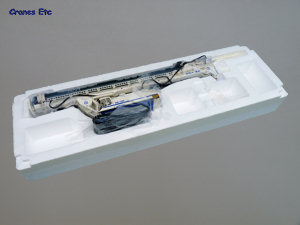 | | The SR-100 inside the box. | 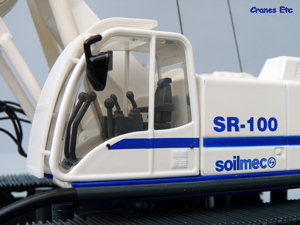 | | The cab accommodates some big knobs. | 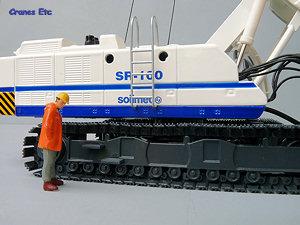 | | Good track details. | 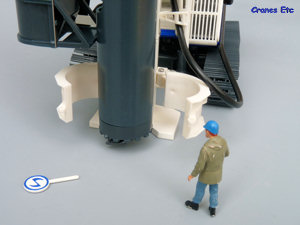 | | Casing clamp opens when you remove the 'pin'. | 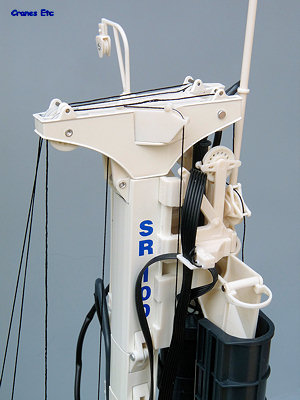 | | The cathead has an auxiliary winch head which simply fits on. | 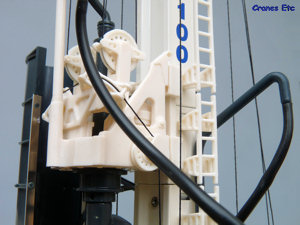 | | The rotary head is plastic. | 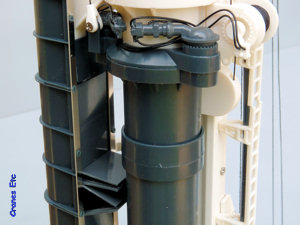 | | The working flaps on the spoil chute which hinge as the casing is driven. | 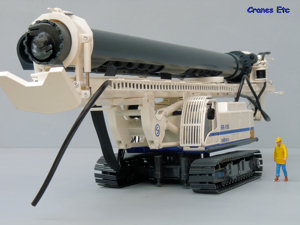 | | Mast folded for movement on site. | 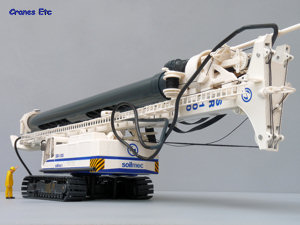 | | Rear view. | 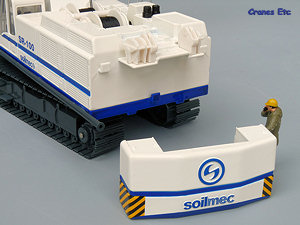 | | The counterweight is detachable. |
|

